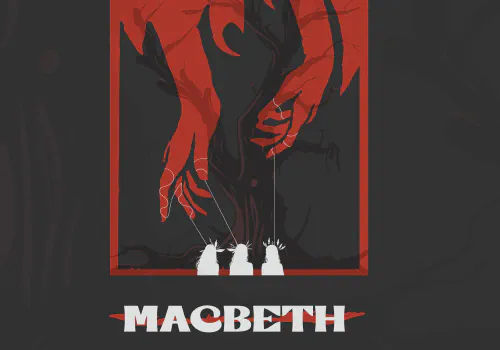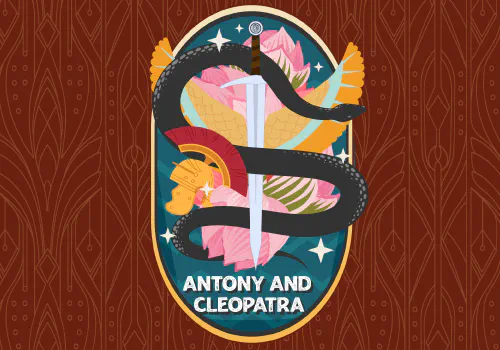By Ace G. Pilkington
Jan Kott wrote in Shakespeare Our Contemporary, that “IfTitus Andronicus had six acts, Shakespeare would have had to take the spectators sitting in the first row . . . and let them die in agony, because . . . no one, except Lucius, remains alive” ([New York: W.W. Norton, 1966], 345). But even Kott admits that Titus Andronicus is not “the most brutal” play by Shakespeare, pointing out that “more people die in Richard III” and that “King Lear is a much more cruel play” (345, 346). Indeed, the members of Shakespeare’s audience, for whom bear baiting and public executions were popular entertainments, expected and got more than a little cruelty with their poetry.
The violence in Titus Andronicus is sometimes attributed to inexperience. In this view Shakespeare is a young playwright who inexpertly adapts Senecan closet drama to the Elizabethan stage. This, however, is to ignore what happens in his later plays. Severed heads are carried on in Macbeth, Cymbeline, and Measure for Measure. Not only do these three works represent three genres—tragedy, romance, and comedy—but all are mature Shakespeare, written in the reign of King James. In the same period of the Bard’s career, Gloucester is blinded on stage, and both Iago in Othello and Don John in Much Ado about Nothing are promised (as Aaron is in Titus Andronicus) post-play tortures.
Titus Andronicus has, like Hamlet, been misinterpreted by critics who did not see what kind of play it was, or if they did, failed to understand the conventions of revenge tragedy, a kind of play that goes back to the Greeks and Romans and explores the nature of justice and revenge. If Titus Andronicus is compared with other plays of its own kind, it does not seem unusually bloody. For example, Kate Bassett’s review of a twenty-first century London production of Thomas Kyd’s Spanish Tragedy, one of Shakespeare’s inspirations for Titus Andronicus, begins with the question, “Is there a word in our language for gouging out your own tongue?” She goes on to call it “a screech-inducing sort of treat” and to point out that “It sparked an avid fad for revenge dramas and strongly influenced Shakespeare” (“The Spanish Tragedy,” The Independent, Oct. 25, 2009, Web).The Spanish Tragedy probably premiered in the mid to late 1580s, while Shakespeare wrote Titus Andronicus around 1592. Both were wildly popular, so much so that Ben Jonson was complaining about their loyal fans in his audiences as late as 1614 in the Induction to Bartholomew Fair, “He that will swear, Jeronimo or Andronicus, are the best plays yet” ([London: Ernest Benn Limited, 1964], 103–104).
Far from being a bad early example of the revenge tragedy, Titus Andronicus helped to set the pattern for a whole subgenre that grew and flourished between the premiere of The Spanish Tragedy and Jonson’s lament over its continuing popularity. The plots were consistently melodramatic, so much so, in fact, that Shakespeare uses the even more melodramatic play within the play in Hamlet to make the actual play seem realistic by contrast. The scene of action in these evolving revenge tragedies became a court, closed in, cut off from the country, distanced from the audience in time and space. The plays were usually set in Renaissance Italy but Imperial Rome fit the pattern too. The plots became ever more convoluted and the characters themselves more twisted. Dispossessed dukes disguised themselves and planned the ruin of their supplanters; lecherous dukes murdered their wives and arranged to marry their mistresses. Chaste maids and virtuous wives were subjected to all possible temptations and urged to yield by mothers, aunts, and other untrustworthy guardians. The cuckolded husbands and dishonored brothers of these women (some of them, such as Hippolito in Middleton’s Women Beware Women, having interrupted their own amorous intrigues) lurked behind every likely arras, or alternatively, smeared poison in the most unlikely places (Vindice in Tourneur’s The Revenger’s Tragedy put it on the jaw of his dead fiancee’s skull).
It was a world of death, and like the emblematic skull in Vindice’s hand (or in Hamlet’s), the plays sought to remind their audiences of the inevitable end. They also preached the doctrine of a fall from a golden Eden to a leaden court. Bussy d’Ambois, for instance, in Chapman’s play, is presented as a heroic figure who has some sparks of the old lost golden age about him and is therefore unfitted to survive at the French court. Often, the fall from the pre-lapsarian state became a kind of damnation, and the world of the play was turned into a metaphor for hell. This is the case with Beatrice and Deflores in Middleton and Rowley’s The Changeling; Deflores says, “Now we are left in hell.” And Vermandero answers, “We are all there, it circumscribes us here” ([London: Ernest Benn Limited, 1964], 5.3.163–4). At the beginning of the play, Titus’s sense of what is right is so strong that he refuses the imperial throne in favor of Saturninus. By the end he has fallen so far that he kills his own daughter and then Saturninus’s wife, Tamora, having first fed her a pie that contained the flesh of her sons.
It becomes clear both in Titus Andronicus itself and in the plays that followed it that the violence, however horrific, was not an end in itself or an authorial clumsiness. The aim was always something greater. The willingness to form and point out patterns, to place the characters and events in larger contexts, was itself a part of the fabric of English Renaissance drama, descending directly from the morality plays and mystery cycles and appearing in works from varied times and divergent genres. In revenge tragedy, this emphasis on literature as a system, coupled as it was with stock characters and clever variations on a relatively fixed melody line, distanced the audience from the emotional impact of the violence and drew them toward the plot complications and themes. For some this may have meant no more than the modern aficionado’s appreciation of the twists in a spy film; for others it may have led (as Prospero’s Masque for Ferdinand and Miranda does) past the airy actors and the insubstantial audience to the eternal reality that the Renaissance saw lurking behind all deaths, theatrical or historical. For most, it provided an aesthetic image of some of their social ills (Webster’s Duchess of Malfi seems to have been partly based on Penelope, the sister of the Earl of Essex.) An element of the appeal of these plays may well have been that the emotional distancing on the stage functioned as a kind of exaggeration of and release from similar problems in real life. In our own time, Kenjii Yoshino has linked Titus Andronicus to the issues raised by international terrorism (A Thousand Times More Fair: What Shakespeare’s Plays Teach Us About Justice [New York: HarperCollinsPublishers, 2011], 3,4).
Shakespeare certainly works to undercut and distance the violence in Titus Andronicus. As Katharine Eisaman Maus argues, “when Quintus and Martius find Bassianus’s body, the audience knows they are being framed for the murder, and one might expect a playwright to exploit the pathos of the situation, encouraging the audience to pity and sympathize with the innocent characters. Instead, the scene is played for laughs as Titus’s sons struggle farcically to pull one another out of a hole” (“Titus Andronicus” The Norton Shakespeare [New York: W.W. Norton, 1997], 376, 377). Indeed, he exaggerates even his most extreme sources, including Ovid. “Whereas in Metamorphoses one man rapes Philomela and cuts out her tongue afterward, in Titus Andronicus two men rape Lavinia, and they cut off her hands as well. Wheras Progne cooks one child, Titus bakes two” (Maus, 374). And lest anyone should miss the source, the exaggeration, or the ultimately literary nature of the experience, Lavinia uses a copy of Ovid to tell her story.
For Shakespeare, Titus Andronicus was in many ways a beginning, but it was neither a tyro’s failure in technique nor a pander’s concession to the bloodlust of the mob. Already here Shakespeare had learned to manipulate and surpass his sources, just as he educated and challenged his audiences. The violence he uses is theatrical, not real, but it is also emblematical, a mechanism for looking at reality through the lens of intellect, and emotional, a means to understanding suffering through the experience of art. Though the spectators sitting in the stalls may die in their imaginations, they also soar to new heights of understanding and empathy. There was a reason why some playgoers maintained twenty years after Titus Andronicus’s premiere that it was the best play they had ever seen.










